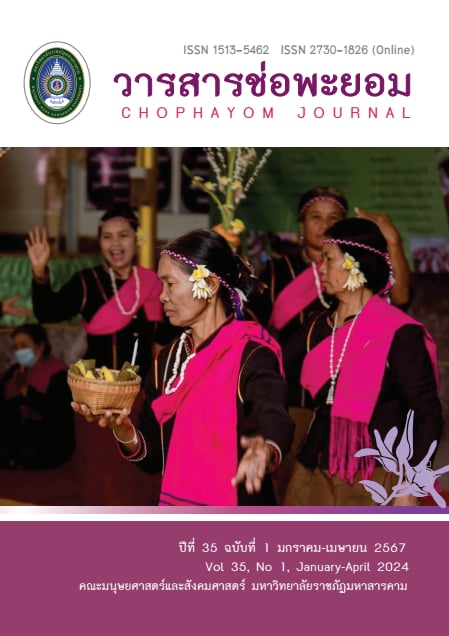Gaocheng Palace Lantern: Cultural Value and Commercialization of Chinese Folk Art in the 21st Century
คำสำคัญ:
Gaocheng Palace Lantern, Chinese Folk Art, Commercializationบทคัดย่อ
The main object of this study is Gaocheng Palace Lantern, and the main objectives of the study include the following three points. Firstly, study the historical evolution of Gaocheng palace lanterns. Secondly, this study aims to analyze the impact of the commercialization process on the dual dimensions of "art" and "social process" of Gaocheng palace lanterns. By studying the process of commercialization of Gaocheng palace lanterns, this study aims to fill the gap in the development of commercialization of Gaocheng palace lanterns after the 21st century. Finally, analyzing the cultural value of Gaocheng Palace Lantern as a folk art in the process of commercialization and the pros and cons of commercialization, the final conclusion is that Gaocheng Palace Lantern as a folk art has both benefits and drawbacks in the process of commercialization. This article uses qualitative research methods to conduct in-depth research on the commercialization of palace lanterns in Gaocheng, Hebei Province, based on literature review, field research, and interviews. Commercialization is a popular concept in economic research, and the content of this study will expand the scope of this concept. At the same time, it will provide reference and inspiration for other researchers, enriching the theoretical system and research methods in related fields.
Folk art is the accumulation of traditional Chinese culture for thousands of years, and is a product of aesthetic significance created by our ancestors through practical life. It is a perfect combination of technology and art. As a treasure of Chinese culture, the craftsmanship spirit of the palace lamp makers in Gaocheng is extremely precious in today's society. Gaocheng Palace Lanterns have strong local characteristics. During festivals, every household and street has red lights hanging high. At the same time, there are also activities such as sightseeing and guessing lantern riddles, which are very interesting.
Keywords: Gaocheng Palace Lantern, Chinese Folk Art, Commercialization
เอกสารอ้างอิง
Appadurai, A. (1986). The Social Life of Things: Commodities in Cultural Perspective . New York: Cambridge University Press.
Bai, W.,& Song, Y. (2010). Intangible cultural heritage preservation and transmission revisited. Social Science Journal, 06, 66-69.
Huang,B.C,&Gu,S. (2019). Rural Revitalisation and Creative Transformation of Intangible Cultural Heritage--Taking Nuo Carving Craft as an Example. Journal of Central South. University for Nationalities, 39(06), 50-54.
He, C.H. (2018). Research on the Contemporary Value of Chinese Traditional Crafts. University of Science and Technology Beijing.
Liu, Y., & Wang, X. (2010). Ligaocheng Palace Lanterns to make noise at the "World Expo." Shijiazhuang Daily.
Liu, C.X. (2008). Local and public nature of intangible cultural heritage. Journal of Guangxi University for Nationalities, 03, 76-80.
Ma,L.M. (2019). Study on the New Media Communication of "Gaocheng Palace Lantern". Hebei University.
Mayer, R. (2008). The Latest English-Chinese Dictionary of Art Terms and Techniques. Beijing: Central Compilation and Translation Press.
Shang,S.,& Zhang,J.W. (2008). Ligaocheng palace lanterns dress up "Olympic Fuwa." Hebei Economic Daily.
Su,J.J. (2020). Commodification of intangible cultural heritage: theoretical considerations based on foreign studies. China Culture Industry Review, 28(01), 289-304.
Wu, J.W, & Yuan, J.Z. (2013). Commodification, Subjectivity and Reconstruction of Place - The Reinvented Xishuangbanna Dai Garden Water Splashing Festival. Journal of Tourism, 28 (04), 14-15.
Wang,L. (2012). Research on the Artistic Characteristics and Direction of Gaocheng Palace Lanterns. Shaanxi Normal University.
Wan, L., & Gu, J. (2009). Industrialisation development and Commercialization of intangible cultural heritage. Henan Social Science,17(04),20-21+219.
Wang, H.C. (2022). Research on the Innovation of Living Inheritance Mechanism of Intangible Cultural Heritage in the New Era-Taking Liannan Yao Embroidery as an Example. Journal of Qingyuan Vocational and Technical College,15(01),21-29.
Wang,X.,&Bian,L. W. (2009). Ligaocheng Palace Lantern Museum Becomes a Demonstration Site for Industrial Tourism in Hebei Province. Shijiazhuang Daily 11-27(008).
Zhong, W. (2008). Big Red Lantern. External Communication.
Zhang, Y.L.(1999). Dictionary of Villages and Towns in Hebei Province. Zhejiang: Hongqi Publishing House.
ดาวน์โหลด
เผยแพร่แล้ว
รูปแบบการอ้างอิง
ฉบับ
ประเภทบทความ
สัญญาอนุญาต
ลิขสิทธิ์ (c) 2024 วารสารช่อพะยอม

อนุญาตภายใต้เงื่อนไข Creative Commons Attribution-NonCommercial-NoDerivatives 4.0 International License.






